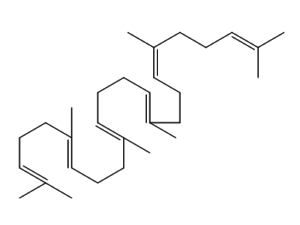Squalene is a natural 30-carbon organic compound originally obtained for commercial purposes primarily from shark liver oil (hence its name, as Squalus is a genus of sharks).
Contents
Uses
- Used in the cosmetic industry and in the vaccines.
Benefits
- Squalene is one of the most common lipids produced by human skin cells.
- It is a natural moisturizer, and occurs as a major component of nasal sebum.
- Squalane is a saturated form of squalene in which the double bonds have been eliminated by hydrogenation. Squalane is less susceptible to oxidation than squalene. Squalane is thus more commonly used than squalene in personal care products, such as moisturizers.
- Toxicology studies have determined that in the concentrations used in cosmetics, both squalene and squalane have low acute toxicity, and are not significant human skin irritants or sensitizers.
- Immunologic adjuvants are substances, administered in conjunction with a vaccine, that stimulate the immune system and increase the response to the vaccine. Squalene is not itself an adjuvant, but it has been used in conjunction with surfactants in certain adjuvant formulations
Cautions
- Squalene has not been well studied in humans, so information on toxicity and side-effects is limited. In animal experiments (rats and dogs) conducted over a three-month interval, no appreciable side-effects and no appreciable toxic signs were observed in serum biochemical tests and hepatic functional tests for squalene-treated animals.7 Since squalene is a naturally occurring lipid component present in healthy diets, it is likely that at reasonable supplemental levels, it is also safe for prolonged administration in humans. Of note, however, is a case of lipoid pneumonia secondary to ingestion of shark oil.29
- Dosage recommendations vary considerably depending upon the application. As an adjunct to assist with cholesterol lowering, the dose studied in conjunction with pravastatin was 860 mg/day. A dose of 500 mg/day might also have some benefit in normalizing lipid values, but evidence suggests high doses (greater than 1 g/day) might be contraindicated for this application.
- As an adjuvant therapy for cancer treatment in humans, information on dosing is again unavailable. Extrapolating from the available animal data, a dose of between 2-5 g/day would appear to be the therapeutic window.
Interactions
Unknown, please consult with your doctor.
Other names
Perhydrosqualene; Dodecahydrosqualene
References
Source: Science for life, http://www.scienceforlife.eu/tekst%20squalene%20and%20its%20clinical%20uses.htm#
Wikipedia, https://en.wikipedia.org/wiki/Squalene#Health_controversy

